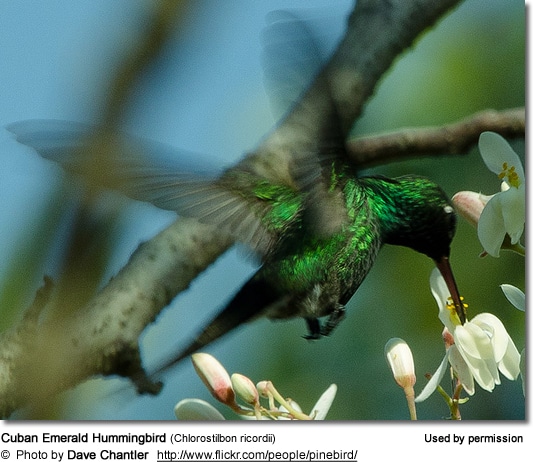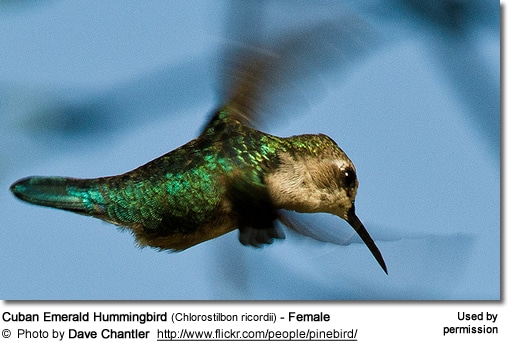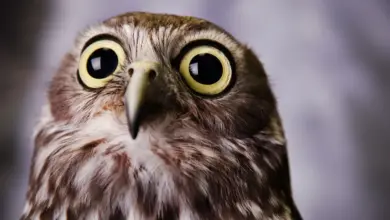Cuban Emerald Hummingbirds
Hummingbird Information
The Cuban Emerald Hummingbirds (Chlorostilbon ricordii, Gervais, 1835) forms a superspecies with the Hispaniolan Emerald (Chlorostilbon swainsonii) and the Puerto Rican Emerald (Chlorostilbon maugaeus).
These three species were formerly separated in genus Riccordia and included the Brace’s Emerald (Chlorostilbon bracei) – an extinct race that was endemic to the main island of the Bahamas, New Providence. However, this form is now by most authorities considered to be a separate species.
Alternate (Global) Names
Spanish: Esmeralda Cubana, Esmeralda Zunzún, Zunzún … Italian: Colibrì smeraldo di Cuba, Smeraldo di Cuba … French: Émeraude de Ricord … German: Kuba Kolibri, Kubakolibri, Kubasmaragdkolibri, Ricord-Kolibri … Czech: Kolibrík kubánský, kolib?ík kubánský … Danish: Cubasmaragd …, Finnish: Kuubansmaragdikolibri … Dutch: Cubaanse Smaragdkolibrie … Norwegian: Kubasmaragd … Polish: zlocik kubanski, z?ocik kuba?ski … Russian: ????????? ?????????? ??????? … Slovak: smaragdovec drobný … Swedish: Kubansk smaragdkolibri, Kubasmaragd … Japanese: kyuabahimeemerarudohachidori, kyu-bahimeemerarudohachidori, ???????????????, ??????????????? … Chinese: ?????
Distribution / Range
Cuban Emerald Hummingbirds are native to:
- Cuba (south of Florida) – including Cayo Coco, Cayo Largo and nearby cays) and Isle of Pines (now renamed to have renamed it the Isle of Youth). The only other hummingbird in Cuba is the Bee Hummingbird (Mellisuga helenae) – the smallest of all birds — and the occasional Ruby-throated Hummingbird in transit.
- The Bahamas (southeast of USA) – Grand Bahama, Great Abaco, Andros, Green Cay); casual in rest of Bahamas.
- The Turks and Caicos Islands (located east-southeast of Florida, USA) and Cuba.
- USA: They are vagrants to the United States (Florida).
They occur in a wide range of semi-open habitats but also live in forests and gardens. They are common in parts of their native range (Stotz et al. 1996).
Description
The Cuban Emerald Hummingbirds is a smallish dark-green hummingbird. The male averages 4 – 4.5 inches (10.5 – 11.5 cm) in length; and the female 3.7 – 4.1 inches (9.5 to 10.5 cm). The female weighs about 0.12 oz or 3.4 grams and the male ~0.18 oz or 5 grams. Both sexes have a whitish spot behind the eye.
The male has a short bill with a black upper beak and a red lower beak with a black tip. The plumage above is dark green and the plumage below is glossy green with a hint of metallic blue. The undertail feathers are white and the tail is deeply forked.
The female resembles the male for the most part, but her plumage below is brownish-grey with green flanks. Her tail is slightly less forked.
Nesting / Breeding
The Cuban Emerald Hummingbirds are solitary in all aspects of life other than breeding, and the male’s only involvement in the reproductive process is the actual mating with the female. They neither live nor migrate in flocks, and there is no pair bond for this species. Males court females by flying in a U-shaped pattern in front of them. He will separate from the female immediately after copulation. One male may mate with several females. In all likelihood, the female will also mate with several males. The males do not participate in choosing the nest location, building the nest, or raising the chicks.
The female Cuban Emerald Hummingbirds is responsible for building a small cup-shaped nest out of green moss lining it with other soft plant fibers, and strengthening the structure with spider webbing. The nest is typically found on a twig 1-3 m high in the bush.
The average clutch consists of two white eggs, which she incubates alone, while the male defends his territory and the flowers he feeds on. The young are born blind, immobile, and without any down.
The female alone protects and feeds the chicks with regurgitated food (mostly partially digested insects since nectar is an insufficient source of protein for the growing chicks). The female pushes the food down the chicks’ throats with her long bill directly into their stomachs.
As is the case with other hummingbird species, the chicks are brooded only the first week or two and are left alone even on cooler nights after about 12 days – probably due to the small nest size. The chicks leave the nest when they are about 20 days old.
Diet / Feeding
The Cuban Emerald Hummingbirds primarily feed on nectar taken from a variety of brightly colored, scented small flowers of trees, herbs, shrubs, and epiphytes. In the Bahamas, they appear to be particularly fond of the native Brace’s Century Plant (Agave braceana).
They favor flowers with the highest sugar content (often red-colored and tubular-shaped) and seek out, and aggressively protect, those areas containing flowers with high-energy nectar. They use their long, extendible, straw-like tongues to retrieve the nectar while hovering with their tails cocked upward as they are licking at the nectar up to 13 times per second. Sometimes they may be seen hanging on the flower while feeding.
Many native and cultivated plants on whose flowers these birds feed heavily rely on them for pollination. The mostly tubular-shaped flowers exclude most bees and butterflies from feeding on them and, subsequently, from pollinating the plants.
They may also visit local hummingbird feeders for some sugar water, or drink out of bird baths or water fountains where they will either hover and sip water as it runs over the edge; or they will perch on the edge and drink – like all the other birds; however, they only remain still for a short moment.
They also take some small spiders and insects – important sources of protein particularly needed during the breeding season to ensure the proper development of their young. Insects are often caught in flight (hawking); snatched off leaves or branches, or taken from spider webs. A nesting female can capture up to 2,000 insects a day.
Males establish feeding territories, where they aggressively chase away other males as well as large insects – such as bumblebees and hawk moths – that want to feed in their territory. They use aerial flights and intimidating displays to defend their territories.
Metabolism and Survival and Flight Adaptions – Amazing Facts
Song / Vocalizations
Its song consists of a vigorous repetition of the chit call usually sung by several dozen breeding males in loose leks (= gathering of males for competitive mating displays).
Species Research by Sibylle Johnson
Please Note: The articles or images on this page are the sole property of the authors or photographers. Please contact them directly with respect to any copyright or licensing questions. Thank you.









